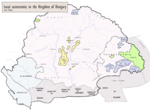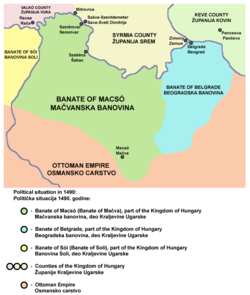- Banovina of Mačva
-
Banovina of Mačva
Banatus Machoviensis
Мачванска бановина
Mačvanska banovina
Macsói bánságbanovina of the Kingdom of Hungary ← 
13th century–16th century  →
→
 →
→Banovina of Mačva in 1490 History - Established 13th century - Disestablished 16th century Today part of Serbia History of Serbia 
This article is part of a seriesBy century 9th · 10th Prehistory Starčevo · Vinča · Scordisci · Triballi Roman (Illyria; Moesia · Pannonia · Dacia) Middle Ages Principality (768-969) (Rascia · Doclea · Zachlumia · Travunia · Pagania) Catepanate · Theme (969–1043) Vojislavljević Doclea (998–1101) Grand Principality (1101–1217) Kingdom (1217–1346) Empire (1346–1371) Fall · Lazar's Serbia (1371–1402) Despotate (1402–1459) Early modern Ottoman (1402–1912) Habsburg Kingdom of Serbia (1718–1739) Great Serb Migrations Modern Serbia Revolution (1804–1815) Principality of Serbia (1817–1882) Kingdom of Serbia (1882–1918) Yugoslavia (1918–1990/2006) German Occupation (1941–1944) Socialist Republic (1944–1990) Federal Republic, then State Union (1990–2006) Republic of Serbia (since 2006) Timeline
Serbia Portal
The Banovina of Mačva (Serbian: Мачванска бановина or Mačvanska banovina, Latin: Banatus Machoviensis, Hungarian: Macsói bánság) was a province (banovina) of the medieval Kingdom of Hungary, which was located in the present-day Mačva region of Serbia.
Contents
History
The region of Mačva came under Hungarian administration after the death of Byzantine emperor Manuel I Comnenus in 1180. and it was first known as Lower Syrmia (Sirmia ulterior) region. The Banovina of Mačva was formed in 1247 by Hungarian king Bela IV who granted it to his son-in-law Rostislav Mikhailovich, a refugee Russian prince. Banovina was named after a town called Mačva (Macho), but the location of this settlement has not been clearly established in modern times. It is suspected that the town of Mačva existed a few kilometers down the river from modern Šabac.
Banovina of Mačva was ruled by several powerful bans. In the 13th century, Béla of Mačva (grandson of Hungarian king Bela IV and son of Rostislav Mikhailovich) ruled Banovina of Mačva as well as Usora and Soli (areas across Drina river in today's northeastern Bosnia).
Mačva soon become apple of discord between the Kingdom of Hungary and the Kingdom of Serbia. King Stephen Uroš I of Serbia tried to conquer Mačva in 1268, but was defeated and captured by the Hungarians. In 1284, Serbian king Stefan Dragutin, son of Uroš I, married Hungarian princess Catherine and received Mačva from Hungarian king Laszlo IV. Since the central power in the Kingdom of Hungary collapsed, Stefan Dragutin ruled an independent kingdom centered in Mačva, which also included regions of Usora and Soli in northern Bosnia, as well as Belgrade, Rudnik and Braničevo. This kingdom was known as the Kingdom of Syrmia (Srem) and Stefan Dragutin ruled it as king until his death in 1316.[1]
Mačva remained in the hands of Dragutin's son Vladislav II until 1319. when northern part of the region along the river Sava was captured by Hungarian king Charles I while the southern part remained firmly under Serbian administration. In the 14th century, the bans of the Gorjanski family (Pavle Gorjanski, Nikola I Gorjanski of Mačva and his son Nikola II Gorjanski of Mačva) which were under the Hungarian suzerainty expanded their rule not only to Bosnia but also to Upper Syrmia and the last one also became the ban of Slavonia and Croatia, which were also parts of the Kingdom of Hungary at the time.
During the 14th century region changed hands between Serbian states and the Kingdom of Hungary, being mostly under Hungarian administration until the 1370s when it was finally captured by Serbian prince Lazar who in 1377-1378 donated several villages in Mačva to his newly founded monastery of Ravanica. Lazars's son despot Stefan Lazarević was officially granted with possession of Mačva by Hungarian king Sigismund in 1403. This was the end of centennial dispute between two states and from then Mačva remained part of Serbian state until this state was conquered by the Ottomans in 1459. Hungarian bans of Mačva existed during this period as well but only as titular holders and the title of ban was usually granted to the ispans (counts) of southern counties of the Kingdom of Hungary and latter to the governors of Belgrade. After the fall of the Serbian Despotate in 1459, Mačva came again under Hungarian administration, but was soon also conquered by the Ottomans.
Administrative divisions
According to the Treaty of Tata in 1426 Mačva was divided into several districts:[2]
- Bitva (Bytthwa),
- Gornja and Donja Obna (Felsewatna and Alsowatna),
- Rađevina (Radio, Ragy),
- Nepričava (Neprichow),
- Ljig (Ligh),
- Kolubara (Collubara),
- Ub (Ubmelek),
- Tamnava (Tamlavamelek),
- Rabas,
- Pepeljevac,
- Debrc,
- Beljin,
- Toplica and
- castle of Bela Stena near present day Valjevo.
Population
The population of banate was mostly Serb and Orthodox as shown in letter of pope Gregory IX from 1229, where pope ordered archbishop of Kalocsa to convert Orthodox Slavs in Lower Syrmia to Roman rite.[3]
List of bans
- Rostislav Mikhailovich, ban of Mačva, a refugee Russian prince.
- Béla of Mačva, ban of Mačva, a son of Rostislav Mikhailovich and a grandson of Hungarian king Bela IV.
- János Alsáni, ban of Mačva (-1360).
- Pál Alsáni, ban of Mačva.
- Pavle Gorjanski, ban of Mačva, 14th century.
- Nikola I Gorjanski of Mačva, ban of Mačva, 14th century.
- Ivan Horvat, ban of Mačva, 14th century (1379-1387)
- Nikola II Gorjanski of Mačva, ban of Mačva, since 1387.
- George I Lackfi, ban of Mačva (1392-1393).
- Ivan Morović, ban of Mačva (1397-?).
- Dezsö Bánfi of Gara, ban of Mačva (-1440).
- Imre Héderváry, ban of Mačva (1442-1445).
- Mate Morović, ban of Mačva (circa 1475).
- Nikola Iločki, ban of Mačva.
See also
References
- ^ Momčilo Spremić, Despot Đurađ Branković i Mačvanska banovina, Beograd 2005, 92-94.
- ^ G.Fejer, Codex diplomaticus Hungariae ecclesiasticus ac civilis, t.X, v. VI, Budae 1844, 809-813.
- ^ T.Smiciklas, Codex diplomaticus regni Croatiae, Dalmatiae et Slavoniae, III, Zagreb 1905, 305-306.[1]
External links
Provinces of the medieval Kingdom of Hungary (late 1200s) Voivodeship of Transylvania · Banate of Slavonia · Banate of Croatia · Banate of Bosnia · Banate of Usora · Banate of Soli · Banate of Mačva · Banate of Braničevo · Banate of Kučevo · Banate of Severin · Banate of Bulgaria
 Categories:
Categories:- History of Vojvodina
- Kingdom of Hungary
- Mačva
- 13th century in Serbia
- 14th century in Serbia
- 15th century in Serbia
Wikimedia Foundation. 2010.


